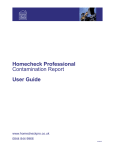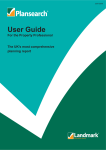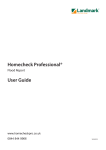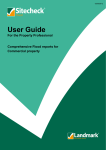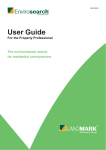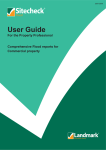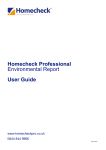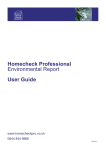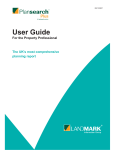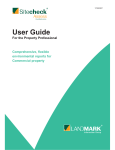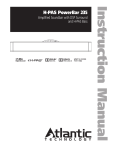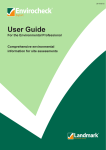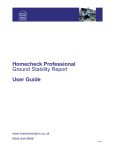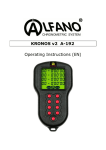Download Homecheck Professional Flood Report User Guide
Transcript
Homecheck Professional Flood Report User Guide www.homecheckpro.co.uk 0844 844 9966 22/06/2009 User Guide Table of Contents Introduction - About this Guide 3 Why should I get a Homecheck Professional Flood Report? 3 How do I get a Homecheck Professional Flood Report? 3 What is my Homecheck Professional Flood Report telling me? 4 Appendix Appendix 1: Data sets used in the Homecheck Professional Flood Report 10 Appendix 2: The Search Code 14 2 1. Introduction – About this Guide 1.1 This Guide has been prepared by Landmark Information Group to assist busy conveyancing practitioners to decide: Whether to obtain a Homecheck Professional Flood Report on behalf of their clients. What that search reveals. 2. Why should I get a Homecheck Professional Flood Report? 2.1 According to the Environment Agency, around 5 million people, in 2 million properties, live in flood risk areas in England and Wales. As an "authorised" element of the Home Information Pack, the Homecheck Professional Flood Report gives the practitioner and their client the vital information they need to decide whether a property is at risk. 3. How do I get a Homecheck Professional Flood Report? 3.1 A Homecheck Professional Flood Report can be ordered by using one of our order forms or alternatively via our website at www.homecheckpro.co.uk. To obtain an order form or register for an account to order online please contact: Landmark Information Group Limited Legal & Financial The Smith Centre Fairmile Henley-on-Thames RG9 6AB Telephone: Fax: DX: E-mail: Internet: 0844 844 9966 0844 844 9980 154400 Henley-on-Thames 2 [email protected] www.homecheckpro.co.uk 3.2 A separate search should be made for each individual property having a different postal address. 3.3 Order forms should be completed by including: The full postal address and postcode of the property. The name and Document Exchange (DX) number (if applicable) of the practitioner. The practitioner’s file reference and telephone number. A plan of the property (see paragraph 3.4 below). 3 3.4 If you are using an order form it is requested that a plan showing the location of the property is enclosed with your order. If a plan is not supplied there may be difficulties in identifying the location of the property and this may introduce a delay. 3.5 In normal circumstances a Homecheck Professional Flood Report will be despatched to the practitioner within 24 to 48 hours of the receipt of the order. 3.6 The Homecheck Professional Flood Report is also available electronically, normally within 24 hours. 4. What is my Homecheck Professional Flood Report telling me? 4.1 The report will include information from a number of statutory and non-statutory sources, and also provides guidance on the presence of features that could create a flood risk. 4.2 Sitescope has agreements for the supply or collection of data with a number of national data providers. Notably, Sitescope is a Licensed Partner of Ordnance Survey and a Value Added Reseller for the Environment Agency and the British Geological Survey. The currency of the datasets used is determined by the frequency of updates by the data providers under their respective agreements with Sitescope. 4.3 Any person relying on a Homecheck Professional Flood Report must comply with the attached Terms and Conditions. 4.4 The replies in the Homecheck Professional Flood Report will be given in the belief that they accord with the data sets and update cycles listed in Appendix 1, but on the understanding that Sitescope is not legally responsible for them except as detailed in the Terms and Conditions, which may vary from time to time. You should also note the following: This report incorporates flood hazard maps, data and information in relation to flood risk (“Information”) licensed by Risk Management Solutions Inc. (RMS) to Landmark Information Group Ltd (“Landmark”). RMS is not engaged in the insurance, real estate, finance or related industries. The Information provided is not intended to constitute professional advice or an endorsement by RMS of any kind regarding the use and suitability of the Information. The Information is based on the scientific data, mathematical and empirical models, and encoded experience of scientists and engineers, and is inherently imprecise. The Information is being provided “as is”, without any warranty of any kind. RMS disclaims all representations and warranties, express or implied, including but not limited to implied warranties of merchantability, non-infringement and fitness for a particular purpose, or any warranties as to the accuracy, completeness, reliability or certainty of the Information. You rely on the information solely at your own risk. RMS specifically disclaims any and all obligations and liability with respect to any decisions or advice made or given as a result of the Information. In no event shall RMS (or its parent, subsidiary or other affiliated companies) be liable for any direct, indirect, special, incidental or consequential damages (including loss of profits, loss of business and loss of interruption of business), suffered by you, a counterparty or any third party, arising out of (1) any use of or reliance upon this Information; (2) any decisions or advice made or given as a result of the contents of the Information or use thereof; or (3) any errors, omissions or inaccuracies in the Information. 4.5 Sitescope is constantly working with data providers to improve the data sets and the information available to Sitescope may change. Accordingly, there is no protection period relating to a Homecheck Professional Flood Report and practitioners should not attempt to rely on a previous report. Practitioners who rely on a previous report will not have the benefit of Sitescope’s Professional Indemnity Insurance cover. 4.6 Practitioners should note that addresses may have been compared to the Royal Mail Postal Address File standard and therefore may have been changed to comply with this standard. 4 4.7 The report is split into sections, which presents the information in an easy to understand question and answer format. 4.8 The practitioner should normally be able to easily verify that the report has been correctly located on the subject property using the Site Location map. In the event of any doubt as to the correct location the practitioner should raise this immediately with our helpdesk or the agent or reseller. 4.9 The Homecheck Professional Flood Report uses the boundary of the property as the basis of the search if this is digitised. Alternatively, the search can be ordered as a point location and our system will construct a 25m radius circle around this point which will be used as the property boundary for the purposes of the report. Please note that use of the 25m circle is not an attempt to make an approximation of the property boundary. Guidance 4.10 The Homecheck Professional Flood report includes a guidance statement that confirms whether, based on the data revealed in the report, there is any flood risk associated with the property. The replies are colour coded green, amber and red. Green indicates no flood risk has been identified. Amber indicates that, whilst no natural flood risk has been identified, the are records of flood insurance claims. Red indicates that a flood risk has been identified. The issues that give rise to the risk are listed. Enquiries and Replies 4.11 The Homecheck Professional Flood Report will be based on the information listed in Appendix 1 to this Guide. The practitioners’ attention is drawn to the update cycles for this information. 4.12 Section A of the report will include information from Risk Management Solutions Inc. (RMS) as to the potential flood risk up to 250 metres from the property. RMS flood is a modelled dataset, which uses land height, predicted rainfall and a huge variety of other factors to predict both flooding from rivers, and for the first time across Great Britain, surface water flooding, a key factor for flood predictions in urban areas. The report reveals: The potential worst case flood depths, taking flood defences into account, up to 50 metres from, or within 51-250 metres of the property. The potential worst case flood depths, assuming the absence of flood defences, up to 50 metres from, or within 51-250 metres of the property. Any areas at potential risk of surface water flooding, up to 50 metres from, or within 51-250 metres of the property. For the first two questions the appropriate depth band is given and the third question simply gives a yes or no reply. Potential flood depths are grouped into four bands of 0-200mm, 201-500mm, 501-2000mm and more than 2001mm. Where no data is revealed the response "No Known Flood Risk" is given. 5 The data is plotted on up to three maps showing 1 in 75, 1 in 100 and 1 in 1000 year risk. These maps show an area out to 1000 metres from the search centre. Where no data is revealed maps are not plotted Please refer to Appendix 1 to this guide and to the footnotes to section A in the report itself for detailed information on the data used in this section. 4.13 For England and Wales Section B of the report will include information from the Environment Agency as to whether the property is: In or within 250 metres of an area affected by flooding (Zone 3) or extreme flooding (Zone 2). In or within 250 metres of flood defences recorded by the Environment Agency. In or within 250 metres of an area recorded by the Environment Agency as benefitting from flood defences. Where data is reported this will be plotted onto a map for easy reference. For Scotland flooding information has been provided by the Centre for Ecology and Hydrology. Where data is reported estimated flood depths are mapped for a 1 in 100 year event and shown in colour coded bands of 0 to 1 metre, 1 - 2 metres and over 2 metres estimated flood depth. The flood areas have been generated using a generalised technique and should not, by themselves, be used to infer that specific areas are or are not at risk of inundation. Flood risk at any specific location may be influenced by local factors, not least flood defences, that have not been taken into account. Please refer to Appendix 1 to this guide and to the footnotes to section B in the report itself for detailed information on the data used in this section. 4.14 Section C of the report will include information from the British Geological Survey (BGS) as to whether the property is within an area susceptible to groundwater flooding or whether there are geological deposits that indicate the area may be vulnerable to inland or coastal flooding. The search area for this section is 0 - 50 metres from the specified property. Susceptibility to groundwater flooding will report the worst case within the search area and the responses are: None Negligible Low Moderate Moderately High High Where susceptibility is negligible, this means that you need take no further action in relation to groundwater hazard in this area. 6 Where low or moderate susceptibility is indicated, this means that given the geological conditions there may be a groundwater flooding hazard. Unless other relevant information, e.g. records of previous flooding, suggests groundwater flooding has occurred before in this area you need take no further action in relation to groundwater flooding hazard. If there are records of previous incidences of groundwater flooding, then it is recommended that other information e.g. rainfall history, property type, and land drainage information in addition to previous records of flooding be investigated in order to establish relative, but not absolute, risk of groundwater flooding. Where moderately high or high susceptibility is indicated, this means that given the geological conditions in the area groundwater flooding hazard should be considered in all land-use planning decisions. It is recommended that other relevant information e.g. records of previous incidence of groundwater flooding, rainfall, property type, and land drainage information be investigated in order to establish relative, but not absolute, risk of groundwater flooding. Geological Indicators of Flooding simply gives a yes or no reply. Please refer to Appendix 1 to this guide and to the footnotes to section C in the report itself for detailed information on the data used in this section. 4.15 Section D of the report will include information from Norwich Union (NU) as to their assessment of the flood risk to the property and the insurability risk assessment of the property. The flood risk responses are: High Medium Low Negligible May Become Isolated No Data Availble Where the flood risk is "High" based on Norwich Union’s assessment of flood risk, the property has a flood risk more frequent than a 1 in 75 year flood event. Where the flood risk is "Medium" based on Norwich Union’s assessment of flood risk, the property has a flood risk between a 1 in 75 year, and 1 in 250 year flood event. Where the flood risk is "Low" based on Norwich Union’s assessment of flood risk , the property has a flood risk between a 1 in 250 year, and 1 in 1000 year flood event. Where the flood risk is "Negligible" based on Norwich Union’s assessment of flood risk, the property has a negligible flood risk. Where the flood risk is "May become isolated" based on Norwich Union’s assessment of flood risk , the property may become isolated or surrounded by flood waters in the event of a 1 in 250 year flood event. The property itself is unlikely to flood. 7 The insurability risk assessment responses are: Significant High Moderate Low Very Low Negligible May Become Isolated No Data Available Where the insurability risk assessment is "Significant" the insurer’s assessment of flood risk at this property indicates that there is a significant risk of flooding, and without evidence of appropriate flood defences it would not be prepared to insure this property. You may be required to purchase a Flood Risk Assessment survey in order to provide this evidence. Insurer recommends you consider flood protection measures. Where the insurability risk assessment is "High" the insurer’s assessment of flood risk at this property indicates that the property is built on a flood plain and there is a high probability of flooding. Insurer would be prepared to offer cover for flooding if it were to insure this property. Properties with a high probability of flooding may attract higher insurance premiums and/or claims excesses. You may wish to consider looking for suppliers of flood prevention products. Where the insurability risk assessment is "Moderate" the insurer’s assessment of flood risk at this property indicates that the property is built on a flood plain and there is a moderate probability of flooding. Insurer would be prepared to offer cover for flooding if it were to insure this property. Properties with a moderate probability of flooding may attract higher insurance premiums. Where the insurability risk assessment is "Low" the insurer’s assessment of flood risk at this property indicates that the property is built on a flood plain and there is a low probability of flooding. Insurer would be prepared to offer cover for flooding if it were to insure this property. Properties with a low probability of flooding may attract a small increase in insurance premiums to cover the risk. Where the insurability risk assessment is "Very low" the insurer’s assessment of flood risk at this property indicates that whilst the property is built on a flood plain there is a very low probability of flooding. Insurer would be prepared to offer cover for flooding if it were to insure this property. Where the insurability risk assessment is "Negligible" the insurer’s assessment of flood risk at this property indicates that there is a negligible risk of flooding. Where the insurability risk assessment is "May become isolated" the insurer’s assessment of flood risk at this property indicates that in an extreme flood event this property may become isolated or surrounded by flood waters. This property itself is unlikely to flood. Please note that these assessments of the insurability of the property are from Norwich Union. If the response raises concerns you should check with your own insurance company. Where the report advises “No Data Available” for section C this means the location of your property is not yet included in the Ordnance Survey’s Address-Point data. This could occur if your property is newly built or is a plot in a new development. In such cases Landmark can obtain information from Norwich Union on a case by case basis, normally within 2 working days. 8 Should you require Landmark to obtain this information please contact our Customer Service team on 0844 844 9966. Please refer to Appendix 1 to this guide and to the footnotes to section D in the report itself for detailed information on the data used in this section. 4.16 Section E of the report will include information of the flood insurance claim rating for the property's postcode sector. An insurance claims rating for flood risk is derived from the number of flood insurance claims in the postcode sector. Data is gathered from a large number of insurance companies and includes validated claims notified to insurers including river and coastal flood, heavy rainfall and flooding following blockages to sewers etc. They do not include an escape of water from a fixed appliance. The insurance claim rating responses are: High Medium Low Very Low No Data Available “High” is usually (but not invariably) associated with river or coastal flood. It is usually indicative of groups of claims with several properties suffering damage as the result of a specific event. This would indicate a sector with more than 5 claims per 1000 households. “Medium” is usually indicative of groups of houses, not necessarily over a wide area, that have suffered damage as a result of heavy rainfall, over-topping of the rainwater system or their location being on low lying ground. This would indicate a sector with between 2 and 5 claims per 1000 households. “Low” suggests individual claims associated with failure of underground drainage systems or possibly localised events like flooding of the roadway following heavy rainfall. This would indicate a sector with less than 2 claims per 1000 households. "Very Low" indicates there are no recorded claims. "No Data Available" means there are insufficient properties in the postcode sector to make a meaningful assessment. Please refer to Appendix 1 to this guide and to the footnotes to section E in the report itself for detailed information on the data used in this section. 4.17 It should be noted that the data in each section is supplied from different sources and is based on different parameters. This may give rise to what might at first seem to be conflicting responses. For example, data in section D is specific to the subject property whereas the data in section E relates to the postcode sector. A report could therefore be assessed as “High” in section D for both Flood and Insurability Risk and have a “Low” Insurance Claim Rating. 9 Appendix 1: Data Sets Used in the Homecheck Professional Flood Report Title Remarks Areas Benefiting This data set shows those areas benefiting from from Flood Defences demarcated flood defences whereby in a 1% fluvial or 0.5% tidal flood event, areas that would otherwise flood are protected, provided that the defences do not breach. Source Data Type Data Range Update Cycle Section Environment Agency Polygon & Text From 2005 Quarterly B BGS Groundwater Flooding Susceptibility This data set is the first national hazard or susceptibility British Geological Survey (BGS) data set of groundwater flooding. Groundwater flooding is increasingly recognised as a hazard and can be defined as the emergence of groundwater at the ground surface, or the rising of groundwater into man-made ground under conditions where the normal range of groundwater levels is exceeded. Based on geological and hydrogeological information, digital data has been used to identify areas where geological conditions could enable groundwater flooding to occur and where groundwater may come close to the ground surface. The data set defines areas with one of five levels of groundwater susceptibility, ranging from high susceptibility to negligible or no susceptibility. Areas with no data represent areas with no susceptibility to groundwater flooding. The resolution of the modelled output is 50m by 50m cells. The data set is a hazard data set, not a risk data set, meaning that it does not provide any information about the likelihood of a groundwater flooding event occurring. Polygon & Text Not Applicable Annual C BGS Geological Indicators of Flooding This data set identifies areas prone to the two main British Geological Survey (BGS) types of flooding - inland (fluvial floodplains) and coastal/estuarine, based upon the observation of the types of geological deposit present. The data set is a digital map based on the BGS Digital Geological Map of Great Britain at the 1:50,000 scale. It was produced by characterising Superficial (Drift) Deposits on this map in terms of their likely vulnerability to flooding, either from coastal or inland water flow. These Superficial Deposits are considered ‘recent’ in geological terms, most having been formed in the later parts of the Quaternary geological period (i.e. within the last few tens of thousands of years). Observations made during recent major inland and coastal flooding events have demonstrated that the erosion and deposition of these recent geological sediments have produced subtle topographical variations, resulting in landforms such as fluvial and coastal floodplains. The mapping of these landforms, in conjunction with the fluvial and/or coastal deposits that underlie them, has in turn determined the extent of previous coastal and inland flooding. The data set does not take into account any manmade influences such as flood protection schemes, nor does it take into account the possibility of flooding onto low-lying ground that is not occupied by the ‘indicator’ deposits described above. Polygon & Text Not Applicable Annual C 10 Appendix 1: Data Sets Used in the Homecheck Professional Flood Report Title Remarks Source Data Type Data Range Update Cycle Section Extreme Flooding from Rivers or Sea without Defences (Zone 2) Flood Zones are defined by the Government’s Planning Policy Statement 25 on ‘Development and Flood Risk’ for England (PPS25) dated December 2006, which replaces Planning Policy Guidance 25: Development and Flood Risk (PPG25), published in July 2001. The Flood Zones are defined in table D.1 of PPS25 and illustrate the probability of flooding across England for planning consultation and have been identified using the best available data held by the Environment Agency ignoring the presence of flood defences. This data set is Flood Zone 2 (Medium Probability), which comprises areas of land assessed as having between a 1 in 100 and 1 in 1000 annual probability of river flooding (1% – 0.1%) or between a 1 in 200 and 1 in 1000 annual probability of sea flooding (0.5% – 0.1%) in any year. This definition of Flood Zone 2 applies only in England. Equivalent data is also provided for Wales, although in Wales the data does not have the same relationship to Planning Policy and is not referred to as Flood Zones. Environment Agency Polygon & Text From 2005 Quarterly B Flood Defences This is the Environment Agency’s holding of Linear Flood Defences. This data set contains all flood defences constructed during the last five years with a standard of protection equal to or better than 1% for rivers and 0.5% from the sea. Some additional defences, which may be older or may have been designed to provide a lower standard of protection, are also shown where the information is currently available. This layer comprises linear flood defences, for example flood embankments and walls. Environment Agency Polygon & Text From 2005 Quarterly B Flooding from Rivers or Sea without Defences (Zone 3) Flood Zones are defined by the Government’s Planning Policy Statement 25 on ‘Development and Flood Risk’ for England (PPS25) dated December 2006, which replaces Planning Policy Guidance 25: Development and Flood Risk (PPG25), published in July 2001. The Flood Zones are defined in table D.1 of PPS25 and illustrate the probability of flooding across England for planning consultation and have been identified using the best available data held by the Environment Agency ignoring the presence of flood defences. This data set combines Flood Zone 3a (High Probability) and Flood Zone 3b (The Functional Floodplain). Flood Zone 3a comprises land assessed as having a 1 in 100 or greater annual probability of river flooding (>1%) or a 1 in 200 or greater annual probability of flooding from the sea (>0.5%) in any year. Flood Zone 3b comprises land where water has to flow or be stored in times of flood. Strategic Flood Risk Assessments (SFRAs) should identify this Flood Zone (land which would flood with an annual probability of 1 in 20 (5%) or greater in any year or is designed to flood in an extreme (0.1%) flood, or at another probability to be agreed between the LPA and the Environment Agency, including water conveyance routes). These definitions of Flood Zone 3a and 3b apply only in England. Equivalent data is also provided for Wales, although in Wales the data does not have the same relationship to Planning Policy and is not referred to as Flood Zones. Environment Agency Polygon & Text From 2005 Quarterly B 11 Appendix 1: Data Sets Used in the Homecheck Professional Flood Report Title Data Type Data Range Update Cycle Section This dataset describes the surface water and major Risk Management river flood hazard for 75,100 and 1,000 year return Solutions Inc. periods for England, Scotland & Wales. A return period is the statistical probability of the flood happening in any given year. i.e. a 75 year return period is a 1 in 75 chance. The Risk Management Solutions (RMS) data model does not take into account Coastal/Storm Surge Flooding, Dam Failure Flooding, Sewer Overflow Flooding or risk of flooding from the sea. The source data is created using 0.0005 decimal degree grid cells projected using WGS84 (Lat/Long). Landmark has translated the data into British National Grid - as a result of the translation, the data does not appear as a regular grid. Due to this re-projection cell sizes will vary across the country. Two types of major river flood hazard classification are used: defended and undefended. The “defended” data assumes any flood defences present withstand the flood heights for which they were designed. The “undefended” data assumes that no flood defences are present, representing the possible outcome if any defences which are present are breached entirely. The defended dataset makes certain assumptions about flood defences around Great Britain. RMS state these assumptions take into account EA defences, the government defence assumptions from DEFRA, other literature, and discussions with the EA especially around river flood defences in London and the impact of tidal defences along the river including the Thames barrier. This data has flood depth information, grouped into four bands: 0-200mm, 201-500mm; 501-2000mm; 2,000mm and over. Surface water flood hazard is defined in this context as flooding from minor rivers, water flowing across the ground or raised groundwater levels. The surface water hazard does not make any account for any flood defences which may be present. Polygon & Text Not Applicable As Notified A Flood Water Storage Areas The Environment Agency’s holding of ‘Flood Storage Areas’. A flood storage area may be referred to as a balancing reservoir, storage basin or balancing pond. Its purpose is to attenuate an incoming flood peak to a flow level that can be accepted by the downstream channel. It may also delay the timing of a flood peak so that its volume is discharged over a longer time interval. Environment Agency Polygon & Text From 2005 Quarterly B Postcode Sector Insurance Claim Ratings - Flood This data set contains postcode sector based flood insurance claim ratings. Postcode sectors are supplied as digital polygons, to which insurance claim ratings are applied. The rating system has five levels, and is derived from the number of flood insurance claims in the postcode sector. Four levels range from ‘Very Low’ to ‘High’, whilst the fifth category represents postcode sectors that have too few properties contained within them to make an assessment. Crawford & Co Polygon & Text From 2000 Quarterly E Flood Hazard 75,100 and 1000 Year Return Remarks Source 12 Appendix 1: Data Sets Used in the Homecheck Professional Flood Report Title Remarks Source Data Type Data Range Update Cycle Section Property-based Flood Risk This data set provides a property-based flood risk for all residential properties within the UK as supplied by Norwich Union (NU) insurance company. There are five levels of flood risk: High - Property has a flood risk more frequent than a 1 in 75 year event. Medium - Property has a flood risk between a 1 in 75 year and 1 in 250 year event. Low - Property has a flood risk between a 1 in 250 year and 1 in 1000 year event. Negligible - Property has a negligible risk of flooding, or is not on a flood plain. May Become Isolated - Property itself is not at risk of flooding however it may be isolated by flood waters in a 1 in 250 year event. In addition, each property is assigned one of 7 insurability assessments dependant upon the risk of flooding. For this to happen, the Medium (Amber) flood risk is broken down into more granular levels. NU use Ordnance Survey’s Address-Point data to locate each individual address, before running an algorithm to assign individual properties a flood-risk rating and insurability assessment. Norwich Union Point & Text Not Applicable Annually D River Flood Data (Scotland) This raster data comprises 50m cells covering main- Centre for Ecology land UK and was generated using a generalised techand Hydrology nique. The display of this flood hazard therefore is indicative only. It is divided into levels based on the frequency and magnitude of a predicted 100 year term. Raster Cells Not Applicable Not Applicable B 13 Appendix 2: The Search Code Search Code Important Consumer Protection Information This search has been produced by Landmark Information Group of The Smith Centre, Fairmile, Henley on Thames, RG9 6AB (Tel: 0844 844 9966, Fax: 0844 844 9980, Email: [email protected]), which is registered with the Property Codes Compliance Board as a subscriber to the Search Code. The Search Code provides protection for homebuyers, sellers, conveyancers and mortgage lenders, who rely on property search reports carried out on residential property within the United Kingdom. It sets out minimum standards which organisations compiling and/or selling search reports have to meet. This information is designed to introduce the Search Code to you. By giving you this information, Landmark Information Group is confirming that they keep to the principles of the Search Code. This provides important protection for you. The Code’s main commitments The Search Code’s key commitments say that search organisations will: x x x x x Provide search reports which include the most up-to-date available information when compiled and an accurate report of the risks associated with the property. Deal promptly with queries raised on search reports. Handle complaints speedily and fairly. At all times maintain adequate and appropriate insurance cover to protect you. Act with integrity and ensure that all search services comply with relevant laws, regulations and industry standards Keeping to the Search Code How search organisations maintain compliance with the Search Code is monitored independently by the Property Codes Compliance Board (PCCB). If you have a query or complaint about your search, you should raise it directly with the firm, and if appropriate ask for your complaint to be considered under their formal internal complaints procedure. If you remain dissatisfied with the firm’s final resolution after your complaint has been formally considered or if the firm has exceeded the response timescales, you may refer your complaint to the Independent Property Codes Adjudication Scheme (IPCAS). IPCAS can award compensation of up to £5,000 to you if it finds that you have suffered loss as a result of your search provider failing to keep to the Code. Please note that all queries or complaints regarding your search should be directed to your search provider in the first instance, not to IPCAS. IPCAS Contact Details Telephone: 020 7520 3800 Email: [email protected] You can also get more information about the PCCB and IPCAS from Property Codes Compliance Board website at: www.propertycodes.org.uk Please contact our Customer Service team on 0844 844 9966 if you would like a copy of the full search code. 14 Appendix 2: The Search Code Complaints Procedure - Information for customers If you wish to make a complaint, we will deal with it speedily and fairly. We will: • • • • Respond to your complaint within 2 working days of receipt Try and resolve your complaint fully within 2 weeks of receipt. If there are valid reasons for consideration of the complaint taking longer, we will keep you fully informed in writing or via telephone or email as you prefer and you will receive a response at the very latest within 8 weeks. Liaise with counselling organisations acting on your behalf, if you ask us to. Send you a final decision on the complaint in writing. If you are not satisfied with the final decision, you may refer the complaint to the Independent Property Codes Adjudication Scheme (IPCAS) and we will give you contact details. We will co-operate fully with the independent adjudicator during the consideration of a complaint by the IPCAS and comply with any decision. Complaints should be sent to: Customer Relationship Manager Landmark Information Group Limited Legal & Financial The Smith Centre Fairmile Henley-on-Thames RG9 6AB Telephone: 0844 844 9966 E-mail: [email protected] IPCAS can be contacted at: IDRS Ltd, 24 Angel Gate, City Road, London EC1V 2PT Phone: 020 7520 3800 Fax: 020 7520 3829 E-mail: [email protected] 15
















